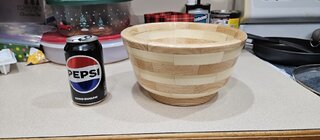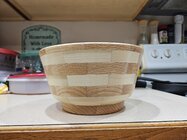Even though I have very little turning experience I thought it would be a fun project to try a segmented bowl. While parts of it were fun, others were quite frustrating!! I think having all the proper tools would make a huge difference but getting all the pieces lined up and flat is no where near as easy as it looks on youtube. For tools all I used was my compound miter saw and lathe. The wood (Poplar and Red Oak) came from Lowe's. The joinery is not good I know but for the tools I had I dont think its horrible. I filled the gaps with Titebond Quick and Thick mixed with saw dust then A LOT of sanding. The finish is just gloss polyurethane.
All things considered with my inexperience, lack of tools and only instruction from youtube I dont think it turned out horrible but you guys be the judge. Brutal honesty is not going to hurt my feelings!! I am looking to improve.
Thanks,
Raymond
All things considered with my inexperience, lack of tools and only instruction from youtube I dont think it turned out horrible but you guys be the judge. Brutal honesty is not going to hurt my feelings!! I am looking to improve.
Thanks,
Raymond






